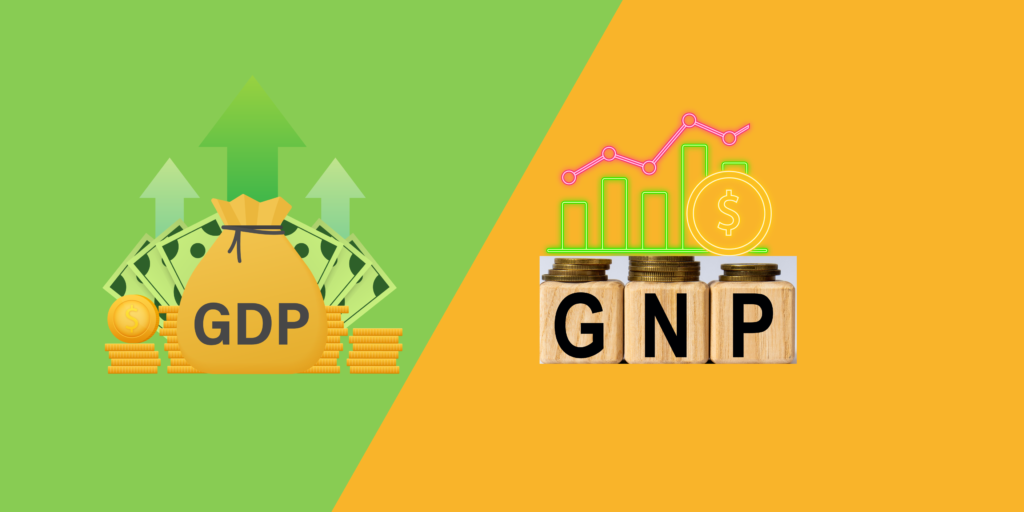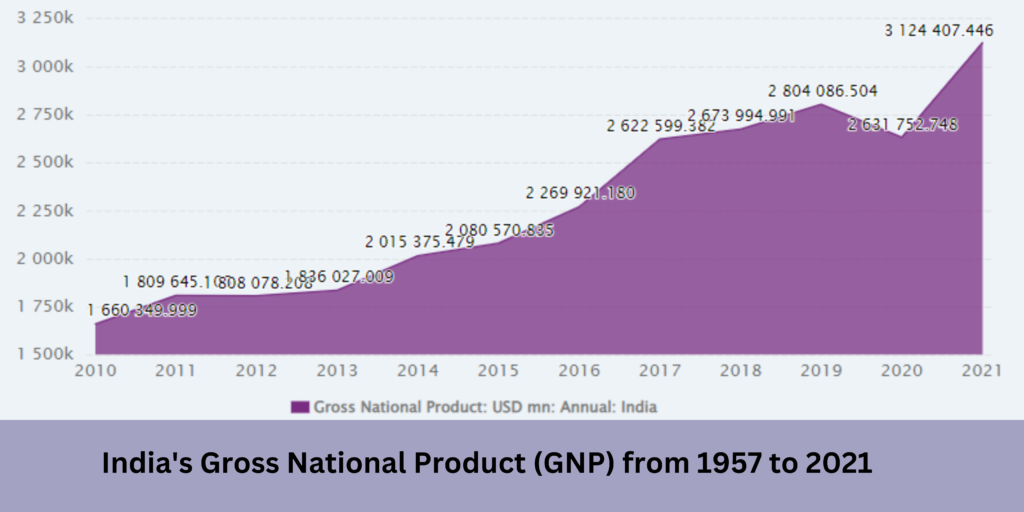
What is the difference between GDP and GNP?
The whole commercial and economic output of a nation is measured by its national income. This is quantified and assessed in monetary terms based on a specified time range. This is crucial when analysing a nation’s current economic situation. GDP & GNP are the two most common tools to analyse the economy.
Gross Domestic Product is known as GDP. This is used to define the overall market value of goods and services generated in a given year. The market worth of the commodities produced is determined by the GNP, or gross national product. An additional factor is the revenue a nation receives from outside.
Studying The difference between GDP and GNP is essential to determining the extent of a nation’s economic growth. In this article, we shall go deeper into their specifics.
GNP vs GDP
| GDP vs GNP | |
| Definition | |
| GDP is the term that refers to the amount of goods and services generated inside a country’s borders within a certain fiscal year. | GNP is the total dollar worth of services and goods produced by all of a country’s residents over a given fiscal year, regardless of where they live. |
| It Measures What, Exactly? | |
| It measures only domestic production. | It measures only the national production. |
| Focus | |
| It focuses on the production that is obtained domestically. | It focuses on the production that is achieved by the citizens living in different nations. |
| Highlights | |
| It highlights the strength of the country’s economy. | It highlights the contribution of the residents to the development of the economy |
| Size of the Business | |
| Local scale | International scale |
| Exempts | |
| The goods and services that are being produced outside the economy are excluded. | The goods and services that are produced by the foreigners living in the country are excluded. |
This article highlights the key difference between GDP and GNP, two crucial ideas that will aid in laying a solid basis for the students.
What is GDP?
GDP provides a financial breakdown of all the commodities and services available. These may be created within a nation’s territorial limits. Over a predetermined time frame, this is measured. However, both citizens of the country and non-citizens may contribute.
Financial analysts can better understand national economic growth by using GDP. The analysts will be able to tell if the nation is falling behind by looking at the GDP. The numbers will cover consumer spending, investments, and net exports. Government spending and paid-in construction expenditures will also be included.
GDP is typically used to gauge a nation’s true economic size. It is therefore typically estimated for a year. In order to evaluate the nation’s financial patterns, financial analysts prolong this term.
When crafting trade policies, decision-makers take the GDP into consideration. Making decisions about interest rates and taxes also depends on it. Local governments also make use of GDP. Economists use it to determine the level of manageable government spending.
GDP is used by economists to analyse fiscal policy. They can also use it to forecast potential increases in the price of oil and other commodities.
What is GNP?
GNP, or Gross National Product, measures the market value of products. Products made both domestically and overseas are taken into consideration. This factor affects how much each citizen contributes to the national economy. But the GNP does not account for the product produced by overseas nationals.
GNP does not take into account foreign investments in a nation. The following are the elements of GNP:
- Governmental spending
- Consumption overall
- The national inhabitants’ net income
- Gross exports
These values are totaled. This is deducted from the revenue generated by people and businesses from other countries. This includes the return on domestic investment.
An analysis of a nation’s GNP shows how well its citizens perform internationally. This analysis also examines the calibre and effectiveness of the nation’s production factors. As a result, GNP can be used to gauge how well a nation’s economy is doing. In comparison to other nations, this is advantageous.

What Distinguishes the GNP from the GNI?
The term “Gross National Product,” or GNP, was replaced by the new term “Gross National Income,” or GNI, in the 1993 System of National Accounts. Now let’s see what is national income. National income is the total money value of all final goods and services produced in a financial year. Both show a nation’s internal productivity in addition to its net revenue from its residents’ enterprises or labour overseas.
When Is The GNP Better Than The GDP?
Gross National Product, often known as Gross National Income, is a measure of a nation’s people’ net foreign income. Researchers assessing the impact of foreign companies or remote employees on a nation’s economy may find value for this statistic.
GNP vs GDP: Which Is Better?
Gross Domestic Product (GDP) is the most widely used indicator of an economy’s overall productivity even though there is no scientific foundation for making that claim. GNP used to be the standard indicator of a nation’s economic output, but by the 1990s, it had lost favour. Know Which One Is Better in Detail.
Conclusion: What is the difference between GDP and GNP?
Gross National Product & Gross Domestic Product are two of the most often used measures of a country’s economic production. Both evaluate the magnitude of an economy’s activity. The fundamental distinction between the two is that while GNP tracks all economic activity carried out by firms and residents of a nation, regardless of location, GDP includes productivity within a nation’s borders. Despite the fact that GDP is more frequently used, their figures are usually comparable.




